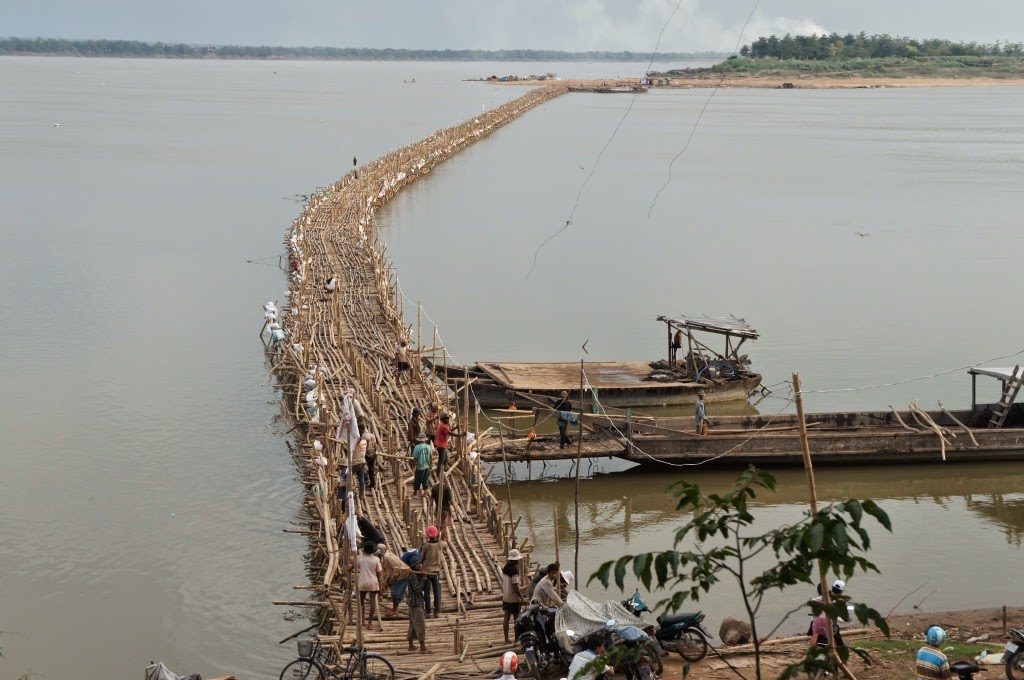Sambo Preykuk is a cultural and historical site located in Sambo
village, Sambo commune, Prasat Sambo district, about 25 kilometers
northeast of Kampong Thom provincial town. The site was once an old
capital named Isanapura and a religious center for the worship of Shiva
Brahmanism.
Many temples were built in Sambo Preykuk during the
reign of King Isanavarman I (AD 616- 635) in the 7th century. The
temples of Sambo Preykuk constructed of solid brick, laterite and
sandstone and decorated by bas-reliefs. The lintel, pillars and the door
frames are all made of sandstone. So far, 140 temples have been
discovered in the forest.
Sambor Prei Kuk, located near Kompong
Thom, 150km south-east of Siem Reap, lies off the main road towards
Cambodia?s capital Phnom Penh.
Kompong Thom is a sleepy little town.
The only hive of activity was the market place next to the Stung Sen
River where we bought some brown palm sugar and Cambodian fragrant rice.
The local ?taxi? was actually an open-air wooden cart pulled by an
antiquated motorbike. Its owner was an elderly man wearing spectacles
with thick lenses.
The journey to Sambor Prei Kuk was interesting in
itself. We saw no other vehicles other than a lone villager cycling
into town, his bicycle laden with hand-made straw baskets. Our van
kicked up thick red dust as we sped on the laterite road. A woman
scrubbing her clothes nearby was oblivious to the dust that swept over
her.
Lest you entertain images of grand temple ruins akin to the
grandeur of the awesome Angkor Wat, you?d be disappointed. Sambor Prei
Kuk is a group of ancient temple ruins scattered within a shady forest.
Originally called Isanapura, it pre-dates Angkor Wat and was the capital
city during the reign of King Isana Varman 1, the son of King
Citrasena.
Few tourists know of it. The only ?horde? here was a
group of Cambodian kids who rushed to our bus, hawking brightly-coloured
homespun scarves at US$1(RM3.50) each. Built at the end of the 6th
century, the ruins are touted to be some of the oldest structures in the
country, covering an area of 5sq km.
About 100 small temples are
scattered throughout the forest. Left in the open and not maintained,
some of the structures are just mere remnants of their original building
? perhaps a broken wall here, a vine-choked edifice there. There are 52
temples in recognisable condition, and another 52 sites where the
original structures are now buried in the ground, visible only as small
hills.
All is not lost. The Ministry of Culture and Fine Arts
together with the Waseda University, supported by The Foundation for
Cultural Heritage and the Sumitomo Fund have started the Sambor Prei Kuk
Conservation Project to restore these ruins.
The main temple
group known as Prasat Sambor is dedicated to Gambhireshvara, one of
Shiva?s many forms. Some of the towers still retain their carvings. Many
are mere ruins now covered by vegetation.
As we walked further,
enjoying the cool serenity of the shady trees, the small group of child
peddlers had grown to 20. The original band selling scarves had been
joined by older children hawking bracelets and trinkets. They were very
persistent, dropping their prices to almost a quarter of the original as
we neared the end of our visit. Sambor Prei Kuk does not match the
splendour of Angkor Wat. Yet its serene forests and solitude make a much
welcome change from the human masses of its famous cousin.
Tuesday, December 9, 2014
Subscribe to:
Post Comments (Atom)






























0 comments:
Post a Comment